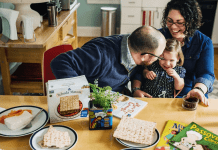My husband and I have walked into my late mother-in-law’s house for the last time.
We are in the process of settling her estate, including the sale of her house and disposition of everything in it.
From a hutch filled with china and crystal goblets to overflowing jewelry boxes and coin collections. And everything in between.
A lot in between.
Her clothes. The Notre Dame sweaters my late father-in-law was so fond of wearing. Her furniture. Furniture inherited from her mother-in-law, still in the same place in the garage where it was originally placed 30 some-odd years ago. My husband’s Cub Scout uniform. Christmas decorations. Lots and lots of Christmas decorations.
Every room, every closet, every shelf, every drawer. Full of stuff. A lifetime of stuff. Two lifetimes, if you count my father-in-law, who passed away 11 years ago.
What to Do With a Lifetime of Stuff
My mother-in-law was a neat and tidy housekeeper. But like many of us (myself included), she lived in a good-sized house with plenty of room to accommodate stuff. Things inherited from her parents and her in-laws. The broken vacuum cleaner waiting for repair in the back of the closet. Hundreds of books read once. You get the picture.
And the cost of disposing of all of that stuff? Having the estate sale company we hired go through every room, every closet, every drawer, separating the trash from the treasures, may cost more than will be generated at the eventual estate sale.
Her house has been transformed into a store, the estate sale company having cleverly arranged and displayed my mother-in-law’s possessions on tables in every room.
All of her possessions with any value, save the very few we kept, each with a tiny white price tag.
Losing your last surviving parent is hard enough. But being the arbiter of which of your parents’ and grandparents’ treasures get saved and which end up sold, donated, or in a landfill? gut-wrenching.
The lesson we have learned from this experience?
Most of the stuff in your house is worthless. And eventually, someone, either you or your kids, will be tasked with the overwhelming job of getting rid of it.
Most of Your Stuff Is Worthless
Most of the stuff in your house is worthless.
Yes, even the stuff you worry the most about, the stuff you think is so good you don’t use it for fear of breaking it, has little to no resale value.
From china, china cabinets, crystal goblets, silver tea sets, pianos, and collectible figurines like Hummels, to grandfather clocks and real pieces of craftsmanship furniture.
Why? Baby boomers have glutted the market with their castoffs, and millennials, the next generation of buyers, don’t want it.
Millennials hate both formal in-home entertaining and use of second-hand goods. With looming student loans, they tend to rent and move often. Who wants to be constantly moving a piano and a grandfather clock from apartment to apartment?
And furniture? There’s no market for so-called “brown furniture,” meaning any furniture (regardless of quality) other than the “mid-century casual” furniture (think clean, lightweight) favored by millennials. Brown furniture is basically firewood.
If it’s not in great condition, it’s also not fit for donation because it can’t be resold.
All of my mother-in-law’s furniture (including the pieces inherited from her mother-in-law and kept for decades)? Straight to the landfill.
Well, Almost Everything…
What do guns, LPs (records), and precious metals/gems have in common?
They are 3 things you might have in your house with a robust resale value.
Silverware also has value, but only if it is real silver and can be melted down.
3 Things You Should Be Doing NOW to Reduce the Amount of Stuff You Have
1. Be viciously thoughtful about holding onto sentimental items.
Here was our goal with sorting through my mother-in-law’s things. Keep just enough to remind us of her, but not so much stuff that our daughters are going to be dealing with it 40 some-odd years from now.
Here’s what we kept:
- A painting to be displayed in our dining room
- My mother-in-law’s treasured Swarovski crystal animal collection (all of which were given to her by her children and grandchildren over the years)
- Jewelry to be divided among the granddaughters
- Each of our daughters got to select 1 item
And that was it.
Well, almost. We did set aside photos to be digitized (with the originals then destroyed).
Was it hard leaving everything else? You bet it was. But we don’t want to be dealing with a lot of stuff years from now (or worse, leaving it to our daughters to deal with).
I try to be viciously thoughtful with my own sentimental items. For example, I don’t save any school papers or art projects from my kids (though I do take photos of my favorites).
2. Buy fewer books.
While used book resellers like Half Price Books do an important service in keeping books in circulation, a surprising number of books end up in landfills because many paper recycling facilities can’t process the the glue that binds book spines.
My resolution last year was to cut down on my book consumption by only reading books that I borrow from the library or purchase on my Kindle e-reader. If you haven’t used a library in years, now is the time to go back. My local library has an app where you can “order” books online, and pick them up the next day on a special “hold” shelf strategically placed next to the check-out kiosk.
How successful was I on my resolution? I read 1 to 2 books a week in 2019, only 1 of which was a hard copy purchased from Amazon.
3. Buy fewer, but better quality, clothes
The world is overflowing with used clothing.
We buy substantially more clothing over our lifetimes than our grandparents did.
Clothing made today is meant to last no more than a few years. In fact, a lot of clothing isn’t even made to withstand more than a few washes.
Think you are “paying it forward” but dropping off a load of unwanted clothes at Goodwill? Think again. Most clothing donations never make it to the racks at Goodwill and only about a third of what does eventually sells.
To really pay it forward, cut down on the amount of clothing you have by buying better quality clothes that last longer.
Keeping What Really Matters
My 5-year-old chose to keep a Christmas music box from her Grandma’s house. It plays “White Christmas” and has tiny ice skaters going around a rink inside. Each Christmas, my mother-in-law would bring out this music box and let each of her granddaughter’s play with it. It’s value in preserving a precious memory of Grandma? Priceless.














So true. People get easily attached to things. Reminds me of Toy Story.
This is a great post. I disagree that millennials aren’t interested in second hand goods, though – there is huge appetite in that demographic for used items, both because of the cost savings (as you mention, the staggering loan debt!) and for environmental reasons. The main barrier is taste and condition.
As a personal wardrobe stylist, see this way too often.
I only help my clients build a wardrobe with clothes that last and not with what I call disposable clothing.
For the environment, our sanity, and wallets keep that in mind next time you go shopping.
Cheap often means trash.
I’d like to add that if a piece of clothing cannot be consigned, then to please donate it to
community centers where clothes are given for free to those in need vs Goodwill centers which sell them.
Having tons of clothes never means having something to wear. However, having the right clothes always means you have outfits you’d love to wear and be seen in.
Always use the good china. Just do it! And if you want to ‘get rid of’ someone’s china, put together a few cups & saucers, cream & sugar bowl in a basket, add teas and other ‘pretty things’, and auction/sell at an auction or give to someone who has children who would love to have a tea party with Nana, or an aunt, or a special friend, or whomever! And the plates? Give a set (service for 2) to young women getting married, to use on “Date Night”. Not too much to pack & move with you, and it can carry on memories of grandparents, elderly neighbors from one’s childhood, ‘the good old days’, whatever you want it to!
Having worked the past 4 yrs in a non-profit I have to agree 100% with this article. Day after day we have people drop off donations of clothing (“it’s in excellent condition & on hangers”), books/magazines, collectibles, furniture, etc. Probably 75% of clothing is not resellable due to age, condition (stains/moth holes/etc) and just not in style. What can’t be sold in our store is sent overseas, some is just thrown away. Certain types of books do sell but most don’t. Few people actually read these days & those that do read on tablets. Personally I love my local library for books & movies. Furniture will only sell if it’s really cheap & I don’t care how valuable it was 20 yrs ago, nobody will spend more than $20 for anything. Collectibles/dishes are just immediate markdowns. That beautiful vase that belonged to your mother or grandmother will probably sell for $2 or less if we’re lucky.
I’m as guilty of holding on to things that remind me of my mother/grandmother/etc. In the past few yrs I have buried my mother and an aunt and uncle, and was responsible for going through their belongings. Photos have been the hardest to get rid of, no one wants them but I feel so guilty throwing them in the trash. But this has inspired me to renew my efforts to clean out the boxes I have set aside without guilt.
I somewhat agree with this – while currently the Millennials don’t care for those things, the next generation, the iGen / Gen Z, are showing a deep interest. I know quite a few who rummage thrift stores looking for cast aways that are now building in value. Albums, certain china…they’re going crazy over Corning Ware and so much more – — oh, an old hand tools and kitchen gadgets. My advice would be to keep what YOU like and value as sentimental, that is always the most important thing…do some Google searches, it is not that difficult nor time consuming if you’re leery about throwing away something. Always remember collectibles and what people are willing to spend on changes like the wind – everything comes back around at some point.
Very true. Very good examples & suggestions. Dealt with similar issues when my parents passed away. I think as far as sentiment goes, it depends on the closeness of the relationship of generations. Distant relatives items may not have the same sentimental value as ones our children grew up knowing.
As for value of items, young folks today seem more detached than ours. They don’t value quality pieces of furniture as we did. It’s a throw away society. When tires of items just toss & buy something new that fancies you. As mentioned, few people do formal entertaining so nice pieces of silver, china, and crystal collect dust in china cabinets. Sad thing is later when it’s gone & someone is antiquing at the local flea market or antique store, they are likely to want something that their family gave away.
As someone who used to entertain more often, primarily church ladies “circle” and have refreshments, nice serving pieces were valued by me. When I go to antique stores & see silver pieces almost black going for pennies, it saddens me. The ironic thing is some will buy those pieces & leave them tarnished (for “patina”) and display on a once nice piece of “brown” furniture that was discarded & later painted white or blue or whatever & distressed to fit today’s trend of “farmhouse” style…Like everything else, it’s a trend & will change.
My distress comes from so many keepsakes that tell history. What would our “living museums” be without handcrafted items from previous centuries. Think if all the items in house museums. They would be empty shells if not for someone passing down items to the younger generation. How many people know what or how to use a spinning wheel or a loom, a sawmill, or ? Yes, you can look at a picture or photograph but to see one in person or even demonstrated is so much more impactful. Our market has been flooded with cheaply made foreign imports that don’t have lasting value, do not hold up to use for very long, (glued or screwed inferior joinery) & has fostered a generation of throw away mentality.
I often wonder about the long term quality of digital photographs. Does anyone know how long they will maintain quality? With the changing technology, when will various storage methods become obsolete? Old photos don’t hold up great but there are really old photos that people have from the beginning of photo taking. I started storing photos on floppy discs long ago, that is now obsolete, then stored on CD/DVD, now flash drive. Will people have the technology to view stored media? What happens when the system crashes? Is all data lost? You can always look at an old photo or album.
Thanks for the valuable information. We knew our kids didn’t want our stuff, but we didn’t know how truly worthless it really is. Our adult daughter sent this to us. To thank her and to save her and her brother the hassle down the road, we’ve decided to send each of them a carton of stuff every couple of weeks. BTW, in your bio you used the word “whose” when I’m sure you meant “who’s”.
We went through this process after our dad passed & totally after our mother passed. There are 4 of us kids plus spouses & grandchildren that helped with this process of sorting, choosing what was donated, kept & tossed. We got through it. We did keep all original photos of yesteryear. We kept & divided some jewelry & paintings too. We photographed them all to share, divided up the more recent years photos according to who was in them. Kept some sentimental items each. We each brought home boxes of our ‘keep’. I need to sort through this again. Somethings I chose to keep that I may let go of eventually. I have my own home if ‘stuff’ that I need to thin down, label what’s important that I hope will be kept in the family. Deciding ‘Who’ will be willing to be the “keeper’ of the ‘family historical photos’ & other items that have survived a few generations already. The whole process while tiring & grueling … it was a time of bonding, healing, sharing a time together of going through memories & belongings of our loved ones & their life & ours with them. ?
Great and useful article. I have one exception. “We did set aside photos to be digitized (with the originals then destroyed).” OMG never get rid of photographs! Technology is evolving and revolving. Having amazing black and white photos of my ancestors from the 1920, provides joy and great conversation pieces to gatherings. Having pictures digitized, it’s a great idea, however it doesn’t give the same experience.